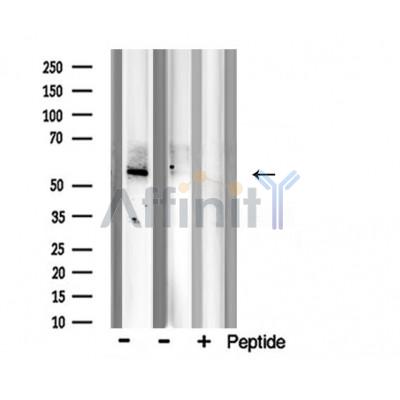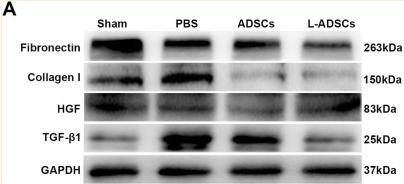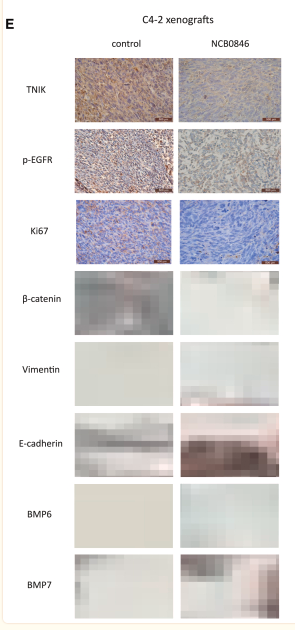BMP7 Antibody - #AF5193
| Product: | BMP7 Antibody |
| Catalog: | AF5193 |
| Description: | Rabbit polyclonal antibody to BMP7 |
| Application: | WB IHC |
| Cited expt.: | WB, IHC |
| Reactivity: | Human, Mouse, Rat |
| Prediction: | Horse, Sheep, Dog, Chicken |
| Mol.Wt.: | 49 kDa; 49kD(Calculated). |
| Uniprot: | P18075 |
| RRID: | AB_2837679 |
Related Downloads
Protocols
Product Info
*The optimal dilutions should be determined by the end user. For optimal experimental results, antibody reuse is not recommended.
*Tips:
WB: For western blot detection of denatured protein samples. IHC: For immunohistochemical detection of paraffin sections (IHC-p) or frozen sections (IHC-f) of tissue samples. IF/ICC: For immunofluorescence detection of cell samples. ELISA(peptide): For ELISA detection of antigenic peptide.
Cite Format: Affinity Biosciences Cat# AF5193, RRID:AB_2837679.
Fold/Unfold
BMP 7; BMP-7; Bmp7; BMP7_HUMAN; Bone morphogenetic protein 7; Bone morphogenic protein 7; Eptotermin alfa; OP 1; OP-1; OP1; Osteogenic protein 1;
Immunogens
A synthesized peptide derived from human BMP7, corresponding to a region within the internal amino acids.
- P18075 BMP7_HUMAN:
- Protein BLAST With
- NCBI/
- ExPASy/
- Uniprot
MHVRSLRAAAPHSFVALWAPLFLLRSALADFSLDNEVHSSFIHRRLRSQERREMQREILSILGLPHRPRPHLQGKHNSAPMFMLDLYNAMAVEEGGGPGGQGFSYPYKAVFSTQGPPLASLQDSHFLTDADMVMSFVNLVEHDKEFFHPRYHHREFRFDLSKIPEGEAVTAAEFRIYKDYIRERFDNETFRISVYQVLQEHLGRESDLFLLDSRTLWASEEGWLVFDITATSNHWVVNPRHNLGLQLSVETLDGQSINPKLAGLIGRHGPQNKQPFMVAFFKATEVHFRSIRSTGSKQRSQNRSKTPKNQEALRMANVAENSSSDQRQACKKHELYVSFRDLGWQDWIIAPEGYAAYYCEGECAFPLNSYMNATNHAIVQTLVHFINPETVPKPCCAPTQLNAISVLYFDDSSNVILKKYRNMVVRACGCH
Predictions
Score>80(red) has high confidence and is suggested to be used for WB detection. *The prediction model is mainly based on the alignment of immunogen sequences, the results are for reference only, not as the basis of quality assurance.
High(score>80) Medium(80>score>50) Low(score<50) No confidence
Research Backgrounds
Induces cartilage and bone formation. May be the osteoinductive factor responsible for the phenomenon of epithelial osteogenesis. Plays a role in calcium regulation and bone homeostasis.
Several N-termini starting at positions 293, 300, 315 and 316 have been identified by direct sequencing resulting in secretion of different mature forms.
Secreted.
Expressed in the kidney and bladder. Lower levels seen in the brain.
Belongs to the TGF-beta family.
Research Fields
· Environmental Information Processing > Signaling molecules and interaction > Cytokine-cytokine receptor interaction. (View pathway)
· Environmental Information Processing > Signal transduction > TGF-beta signaling pathway. (View pathway)
· Environmental Information Processing > Signal transduction > Hippo signaling pathway. (View pathway)
· Organismal Systems > Development > Axon guidance. (View pathway)
References
Application: IHC Species: Mouse Sample:
Application: WB Species: Rat Sample: penile tissues
Restrictive clause
Affinity Biosciences tests all products strictly. Citations are provided as a resource for additional applications that have not been validated by Affinity Biosciences. Please choose the appropriate format for each application and consult Materials and Methods sections for additional details about the use of any product in these publications.
For Research Use Only.
Not for use in diagnostic or therapeutic procedures. Not for resale. Not for distribution without written consent. Affinity Biosciences will not be held responsible for patent infringement or other violations that may occur with the use of our products. Affinity Biosciences, Affinity Biosciences Logo and all other trademarks are the property of Affinity Biosciences LTD.





